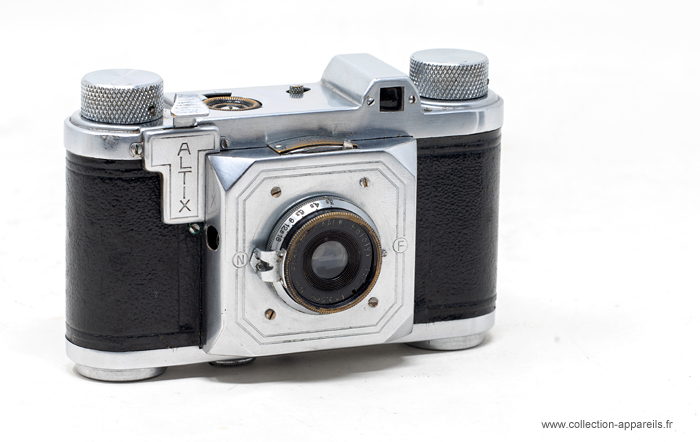|
Eho Altissa Altix I |
Manufactured or assembled in Germany from (Circa) 1938 to (After) 1949.
Index of rarity in France: Rare (among non-specialized garage sales)
Inventory number: 14512
See the complete technical specifications
Chronology of cameras Eho Altissa
The Altix I (or simply Altix when it appeared) is a small viewfinder camera designed for the format 24 x 24 mm on regular perforated 35 mm cine film. It was delivered in 1938 but stopped soon after due to the war and was resumed for a short period after the war. The first variant had a fixed focus lens, but was followed by a second version with simple zone focusing, with indicators for near and far. These earlier models had fine knurling on the wind knobs and an eyelet at the base plate to help with its removal. Also, there was a small button on the top plate to reset the wind lock after each exposure, thus preventing double exposure.
The third pre-war version can be recognized by the different finish of the wind knobs and a depth of field table on the back.
After the war, the Altix I re-emerged with minor modifications, namely missing the bottom eyelet and the lock button at the top plate, among a few minor additional cosmetic changes. At least some of the post-war cameras were plated in nickel instead of chrome.
In the Altix, the release of the shutter only functions when a film is inserted into the chamber. The internal dented wheel actioned by the film perforations unlocks the release.
This specimen corresponds to this second version. It has the typical Laak Pololyt with a focal length of 3.5 cm and a maximum aperture of 3.5.

Second variant of the Eho-Altissa Altix (I)
Short history EHO Altissa written according to the information present on the site: www.altissa-museum.de
Foundation in April 1904 of Photographische Manufaktur Engineer Richard Knoll
In March 1926, taken of charge by Emil Hofert
The July 4, 1927, the company becomes Fabrik photographischer Artikel Emil Hofert vorm. Richard Knoll His head office is established in Dresden, to the 6 EilenburgerStrasse.
In March 1931, dissolution and re-registration with the register companies under the new name of Emil Hofert Eho Kamera-Fabrik Emil Hofert GMBH. The company will be called later Eho Kamera-Fabrik Emil Hofert GMBH counts at this time approximately 30 employees.
In January 1935, after the death of Emil Hofert, his collaborator, Berthold Altmann starts again the company. Is followed from there a new registration under the name of Eho Kamera-Fabrik Emil Hofert GMBH Berthold Altmann owner.
In 1937, the Company moves in N° 38 of LortzingStrasse, its personnel did to 60 colleagues meanwhile.
In 1940, the registration is renewed in Amca-Camera-Werk Berthold Altmann (Amca for Altmann-cameras.)
In 1941, new designation Altissa-Camera-Werk Berthold Altmann.
In 1945, the factory is completely destroyed at the time of the raid of the February 13/14th bombardment which razes practically the city of Dresden.
In 1946, the business starts again in N° 17 of BlasewitzerStrass with about thirty employees.
In 1948, foundation of one second company, The Aldo-Feingeräte GMBH. Simple microscopes and special accessories for movie cameras produced at the same place. On the whole, more than 100 persons are employed in the two companies.
In 1951, the company, still under private status, employs 160 collaborators on the whole.
In 1952, GDR issues the nationalization of the establishments. Berthold Altmann goes to be established in West Germany, but one doesn’t know if it made this choice before or after expropriation. The company is called now VEB OPTIK Altissa-Camera-Werk and is placed under the control of VVB OPTIK of Jena.
In 1953, the workforce counts approximately 300 employees. The company is now placed directly under the control of the ministry and is called VEB Altissa-Camera-Werk.
In 1958, studies are undertaken aiming at integrating the establishment in a group designate VEB Kamera- und Kinowerke Dresden.
In 1959, implementation of integration: the administrative department and manufacture are separated, the production still remaining at the same place initially, legal independence ends and the name Altissa disappears.
With beginning of the year 60, liquidation of the last produced models and final stop of manufacture.
Interesting links or bibliography :
Add a link or element of bibliography, a picture taken with this camera, a picture of box or an ads about this camera
Your photos taken with the same camera:
Cameras from Ebay France (Eho Altissa) (Uploaded each 3 hours)
 Eho Super Altissa. Étui pour appareil photo années 1930. Avec courroie en cuir 5,00 euros Finira le 04-05-2024 à 13:59:21 |








